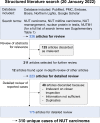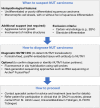NUT Carcinoma-An Underdiagnosed Malignancy
- PMID: 35957893
- PMCID: PMC9360329
- DOI: 10.3389/fonc.2022.914031
NUT Carcinoma-An Underdiagnosed Malignancy
Abstract
NUT carcinoma (NC) is a rare and highly aggressive malignancy with a dismal prognosis and a median survival of 6-9 months only. Although very few cases of NC are reported each year, the true prevalence is estimated to be much higher, with NC potentially widely underdiagnosed due to the lack of awareness. NC primarily occurs in midline structures including thorax, head, and neck; however, other sites such as pancreas and kidney are also affected, albeit at lower frequencies. NC is characterized by a single translocation involving the NUTM1 (NUT midline carcinoma family member 1) gene and different partner genes. The resulting fusion proteins initiate tumorigenesis through a mechanism involving BET (bromo-domain and extra-terminal motif) proteins such as Bromodomain-containing protein 4 (BRD4) and inordinate acetylation of chromatin, leading to the dysregulation of growth and differentiation genes. While no clinical characteristics are specific for NC, some histologic features can be indicative; therefore, patients with these tumor characteristics should be routinely tested for NUTM1. The diagnosis of NC using immunohistochemistry with a highly specific antibody is straightforward. There are currently no standard-of-care treatment options for patients with NC. However, novel therapies specifically addressing the unique tumorigenic mechanism are under investigation, including BET inhibitors. This review aims to raise awareness of this underdiagnosed cancer entity and provide all patients the opportunity to be properly diagnosed and referred to a clinical study.
Keywords: BET inhibitor; BRD4; NUT carcinoma; NUT rearrangement; NUTM1.
Copyright © 2022 Lauer, Hinterleitner, Horger, Ohnesorge and Zender.
Conflict of interest statement
The authors declare that the research was conducted in the absence of any commercial or financial relationships that could be construed as a potential conflict of interest. The Tübingen University Hospital receives compensation for contributions to the ongoing NUT carcinoma study (NCT02516553), sponsored by Boehringer Ingelheim Pharma GmbH & Co. KG. Medical writing support for the development of this manuscript was provided by Physicians World Europe GmbH (Mannheim, Germany), funded by Boehringer Ingelheim Pharma GmbH & Co. KG.
Figures





Similar articles
-
NUT Carcinoma: Clinicopathologic features, pathogenesis, and treatment.Pathol Int. 2018 Nov;68(11):583-595. doi: 10.1111/pin.12727. Epub 2018 Oct 26. Pathol Int. 2018. PMID: 30362654 Review.
-
NUT carcinoma, an under-recognized malignancy: a clinicopathologic and molecular series of 6 cases showing a subset of patients with better prognosis and a rare ZNF532::NUTM1 fusion.Hum Pathol. 2022 Aug;126:87-99. doi: 10.1016/j.humpath.2022.05.015. Epub 2022 May 24. Hum Pathol. 2022. PMID: 35623465
-
NUT Carcinoma: Clinicopathologic Features, Molecular Genetics and Epigenetics.Front Oncol. 2022 Mar 16;12:860830. doi: 10.3389/fonc.2022.860830. eCollection 2022. Front Oncol. 2022. PMID: 35372003 Free PMC article. Review.
-
Thoracic NUT carcinoma: Common pathological features despite diversity of clinical presentations.Lung Cancer. 2021 Aug;158:55-59. doi: 10.1016/j.lungcan.2021.06.008. Epub 2021 Jun 8. Lung Cancer. 2021. PMID: 34119933
-
Clinicopathological and Preclinical Findings of NUT Carcinoma: A Multicenter Study.Oncologist. 2019 Aug;24(8):e740-e748. doi: 10.1634/theoncologist.2018-0477. Epub 2019 Jan 29. Oncologist. 2019. PMID: 30696721 Free PMC article.
Cited by
-
Clinical Network Systems Biology: Traversing the Cancer Multiverse.J Clin Med. 2023 Jul 7;12(13):4535. doi: 10.3390/jcm12134535. J Clin Med. 2023. PMID: 37445570 Free PMC article. Review.
-
Molecular characterization of NUT carcinoma: a report from the NUT carcinoma registry.Clin Cancer Res. 2025 Jul 24:10.1158/1078-0432.CCR-25-1071. doi: 10.1158/1078-0432.CCR-25-1071. Online ahead of print. Clin Cancer Res. 2025. PMID: 40704901 Free PMC article.
-
Transcriptomic profiling of a late recurrent nuclear protein in testis carcinoma of the lung 14 years after the initial operation: a case report.Transl Lung Cancer Res. 2024 Jul 30;13(7):1756-1762. doi: 10.21037/tlcr-24-259. Epub 2024 Jul 11. Transl Lung Cancer Res. 2024. PMID: 39118893 Free PMC article.
-
Primary pulmonary nuclear protein of the testis midline carcinoma: case report and systematic review with pooled analysis.Front Oncol. 2024 Jan 9;13:1308432. doi: 10.3389/fonc.2023.1308432. eCollection 2023. Front Oncol. 2024. PMID: 38264746 Free PMC article.
-
BET Bromodomain Inhibitors: Novel Design Strategies and Therapeutic Applications.Molecules. 2023 Mar 29;28(7):3043. doi: 10.3390/molecules28073043. Molecules. 2023. PMID: 37049806 Free PMC article. Review.
References
-
- Kubonishi I, Takehara N, Iwata J, Sonobe H, Ohtsuki Y, Abe T, et al. . Novel t(15;19)(q15;p13) Chromosome Abnormality in a Thymic Carcinoma. Cancer Res (1991) 51(12):3327–8. - PubMed
-
- Vargas SO, French CA, Faul PN, Fletcher JA, Davis IJ, Dal Cin P, et al. . Upper Respiratory Tract Carcinoma With Chromosomal Translocation 15;19: Evidence for a Distinct Disease Entity of Young Patients With a Rapidly Fatal Course. Cancer (2001) 92(5):1195–203. doi: 10.1002/1097-0142(20010901)92:5<1195::aid-cncr1438>3.0.co;2-3 - DOI - PubMed
-
- French CA, Rahman S, Walsh EM, Kuhnle S, Grayson AR, Lemieux ME, et al. . NSD3-NUT Fusion Oncoprotein in NUT Midline Carcinoma: Implications for a Novel Oncogenic Mechanism. Cancer Discovery (2014) 4(8):928–41. doi: 10.1158/2159-8290.CD-14-0014 - DOI - PMC - PubMed
Publication types
LinkOut - more resources
Full Text Sources

